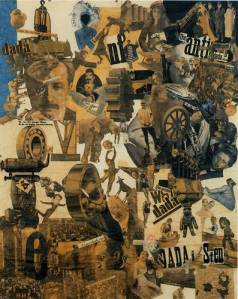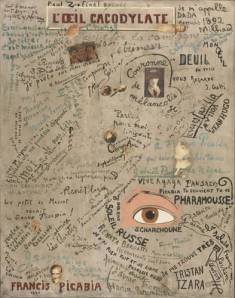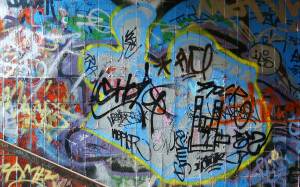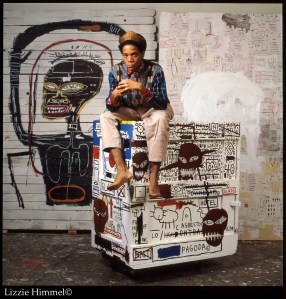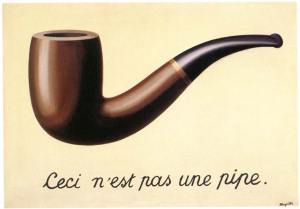Everything changed in the 20th century. Cubists Picasso, Braque and Gris first incorporated text into painting and collage, both gigantic leaps forward in how materials were used in art – but more importantly the jarring juxtaposition of text mixed with traditional painting. Text didn’t yet have a message, it was simply incorporated as part of a material that contained newsprint – so modern as to be up-to-the-day contemporary, a feat without precedent. It might have terrified the classicists, born in the mid-1800’s, art that simply couldn’t be placed.
Pablo Picasso. Guitar. 1913 Juan Gris. The Sunblind. 1914
Dada incorporated text into their work as a rule of thumb. Brash and dexterous, Dadaist manifestos are hilariously brilliant reminders of a time when art was taken seriously and had a cultural relevance, which of course the Dadist’s tried to smash. Anti-war, anti-art culture and anti-bourgeois, the Dadists were also the first movement to incorporate their name into their work, something these days that’s akin to our own DNA.
Hannah Höch. Cut with the Kitchen Knife through the Last Weimar Beer-Belly Cultural Epoch in Germany. 1919
Francis Picabia runs through both Cubism and Dada straight into Surrealism. But before that, in same year he denounced Dada, Picabia crafted The Cacodylic Eye (1921), perhaps the most consistently modern text-art ever created. The canvas (58 x 46″) is nothing more than an eye, a few collaged photographs and the signatures of writers, artists and musicians who visited Picabia’s studio or went to his parties. Meant as a parody, it incorporates Dada’s profound sense of self-identity…
… and also it’s complete sense of the absurd. Better yet, in terms of text art, it IS text art, the first major piece I know of where image (or general lack of) is in service of the text and not, as is still generally the rule, the other way around. It’s also the first work to acknowledge the signature of the artist (in any genre) as being unique it its own right. The contemporary equivalent is graffiti, both the traditional tag and the modern, well, Banksy.
Better yet: Basquiat.
Lastly, for this era, there’s Magritte:
Magritte. This is Not a Pipe. 1928
Well it’s not text-art either, but it’s pretty damn smart, probably the most famous text piece of the period. Too bad Duchamp made the whole damn painting thing irrelevant 11 years earlier when he exhibited Fountain (signed by R. Mutt) in 1917. Still, it sells a lot of postcards.


